Mobility as a Service Market by Service (Ride-Hailing, Car Sharing, micro-mobility, Bus, Train), Solution, Transportation, Vehicle, OS, Business Model, Payment (Subscription, PAYG), Commute (Daily, Last Mile, Occasional) Region - Global Forecast to 2030
[218 Pages Report] The global mobility as a service market size is valued at USD 5.7 billion in 2023 and is expected to reach USD 40.1 billion by 2030, at a CAGR of 32.2% over the forecast period. With rapid urbanization, congestion and traffic-related challenges are increasing. MaaS offers a solution by providing users with multimodal transportation options, which in turn reduces the number of private vehicles on the road, and alleviates traffic congestion. In most cases, these services are flexible and highly customized per independent user. Faster internet connectivity, falling vehicle ownership, and the need to reduce traffic congestion and vehicular emissions will fuel the demand for seamless MaaS applications for end-to-end multimodal transport solutions.
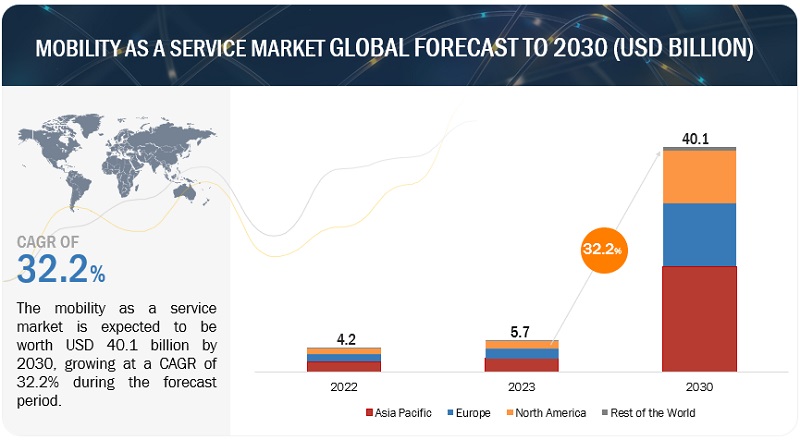
To know about the assumptions considered for the study, Request for Free Sample Report
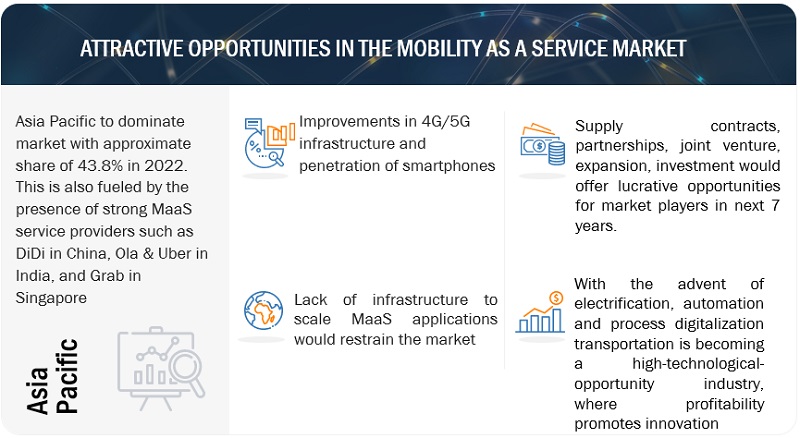
To know about the assumptions considered for the study, download the pdf brochure
Mobility as a Service Market Dynamics
Driver: Improvements in 4G/5G infrastructure and penetration of smartphones
As an internet-enabled service, connectivity is a basic requirement for MaaS. According to the International Telecommunication Union, by the end of 2023, an estimated 64.4% of the global population, or 5.16 billion people, will be using the Internet. Smartphones are vital infrastructure for new mobility models since mobility services like ride-sharing run on smartphones and require good connectivity. Over the last few years, smartphone use has increased significantly across the world, with developed countries accounting for around 80% of smartphone ownership.
5G network and better telecom infrastructure are expected to pave the way for a revolution in cities and in inter-city mobility. Wireless communication technologies (such as DSRC) can help improve traffic safety and increase traffic flow throughput. With onboard units (OBU), connected and automated vehicles (CAVs) can reduce the driver's perception-reaction time and improve safety. Vehicular communication can enable CAVs to collect information from other vehicles and roadside units (RSUs) and coordinate with other CAVs to control and manage the platoon, such as merging, splitting, and maintaining a particular gap. The ongoing development of OBU, RSU, etc., enables and enhances the MaaS of vehicle platooning and would require better and faster telecom infrastructure. Hence, the increasing penetration of smartphones with efficient telecom infrastructure will not only assist vehicle platooning for MaaS but also assist in seamless navigation and payment services through MaaS mobile applications
Restraint: Lack of infrastructure to scale MaaS applications
For MaaS to work, a user must be able to access all available transport modalities on one application. This application needs to host a variety of mobility operators and transport companies with their unique pricing and conditions of service. Mobility as a service, at least in its present form, has little commercial sustainability and will probably not scale due to the complex software involved and difficulties in managing data collected and settling financials. While some operators have the capacity to develop their own software, many cannot. The differences in approach to the software involved, depending on the objectives of the operator, create a disjointed experience for the user and may lead to legal and ethical questions being raised about the handling of data. MaaS pilots around the world have not yet achieved the full set of goals foundational to the idea of MaaS, despite the enthusiasm of municipalities and transport professionals, as well as the proliferation of user apps. Aggregation of mobility services offers journey planning, fare determination, fare payment, and ticketing in one service and subsequently splits the revenue generated by the platform between the transportation providers on the platform.
To be attractive and draw customers away from the car-ownership model, MaaS players must achieve a range of services and options for users at scale, nudging them where necessary to make optimal choices for their personal needs. Stakeholders must thus have a trustworthy partnership with public transport operators, who have much to lose should their assets become under-utilized.
The increased complexity of the software used in developing the application, the lack of a regulatory structure to facilitate the integration of public transport authorities with private transportation providers, and poor infrastructure for payment settlement and ticketing solutions restrict the ability of a MaaS platform to scale; this is likely to stunt the growth of the MaaS market
Opportunities: Inclusion of on-demand ferry and freight services
Urban transportation systems are usually run by state-owned companies, while intercity transport is mostly run by private entities. Thus, pricing for urban transportation is not flexible in general, while ferries (and airlines as well) adopt flexible pricing schemes based on modern revenue-management techniques. With the advent of electrification, automation, and process digitalization, transportation is becoming a high-technological-opportunity industry where profitability promotes innovation. These principles easily apply to MaaS and, more specifically, MaaS in the ferry industry.
In the urban context, mobility is largely based on transport mode ownership. Hence, MaaS aspires to transform the existing asset ownership model into a subscription-based mobility model. However, in the case of sea passenger transportation, very few people own a vehicle (i.e., a ship/catamaran/yacht, etc). Consequently, for sea trips, the main objective of MaaS is to fill the need for an integrated system that offers different transport solutions together and consolidates trip planning and ticketing for every part of the total trip.
MaaS application providers can extend their services in the commercial freight segment as well. Their capability to connect users to on-demand transportation allows them to help supply chain players with their load management. Using MaaS applications can benefit supply chain stakeholders by reducing their overall cost and helping them lower supply chain emissions.
MaaS is also used in Freight Brokering, in which shippers and carriers connect on-demand to ship-specific loads. This involves the integration of different transport modes and services to optimize the movement of goods, making freight logistics more efficient, cost-effective, and sustainable. Existing players in this area include Transfix, Convoy, and Uber Freight, which provide apps that serve as an aggregated marketplace.
Thus, there is a huge opportunity for MaaS application providers to integrate on-demand ferry and freight services into their service offerings to open up new revenue streams.
Challenges: Difficulty in integrating ticketing and payment systems
In order to accomplish complete implementation of MaaS it is important to integrate payment of all the transport modes used in a single app. Thus, the user can manage the entire transportation experience through the MaaS app instead of being redirected to another app or another external system to pay for the ticket. The involvement of different ticketing and payment gateways and the lack of an account-based system has proved to be inconvenient for users, deterring them from adopting MaaS applications.
Seamless partner settlements and financial management are important to encourage a critical mass of operators to participate in a single MaaS platform. The higher the number of transportation providers, the greater the appeal of the application for users.
Sometimes public transport systems have physical barriers and require a ticket validation for access. For validation by MaaS applications, such public transport systems must facilitate the scanning of smartphones. Due to the involvement of multiple stakeholders, such as the payment gateway, ticket verification structures, and financial settlement parties, MaaS application providers are facing logistical and regulatory challenges in integrating a seamless journey planning and ticketing experience for their users.
Mobility as a Service Market Ecosystem
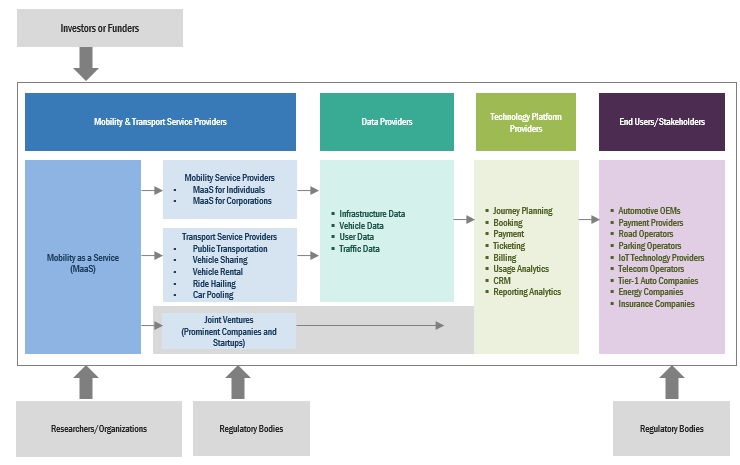
B2B to dominate the revenue generation business model.
A business-to-business (B2B) model is one in which a business deals in commercial transactions with another business. B2B mobility sharing allows the sharing of mobility services with other businesses to reduce vehicle parking space and the number of fleets by enabling car-sharing services within an organization; this helps to lower traffic congestion and emission from vehicles. The utilization of B2B mobility services improves business processes and results in higher employee satisfaction with improved productivity of the workforce. Major service sector regions like the US and Europe thus have a dominant share in the segment. IoMob (Spain) is the first B2B player to develop and launch a MaaS solution that simultaneously offers intercity mobility travel coupled with intracity and micro-mobility services. For instance, for the Renfe project in Spain, IoMob integrated Renfe’s high-speed and suburban rail service between Madrid and Barcelona with a range of services such as taxis and ride-hailing (Cabify), bike sharing, and car sharing. Europe and North America are expected to drive the B2B business model in the market for mobility as a service, while the Rest of the World is projected to be the fastest-growing regional market. Europe and North America were estimated to account for approximately 71% of the market in 2021. Key players operating in the B2B mobility sharing market include Car2go (Germany), Lyft (US), Sixt (Germany), and Uber (US).
Technology Platforms solutions leads the mobility as a service market in terms of value.
Mobility as a Service (MaaS) technology platforms play a crucial role in enabling the seamless integration of various transportation services and modes into a single, user-friendly interface. The technology platform is basically an app that serves as an open platform for integrated mobility. The purpose of this platform is to facilitate the opening up, interoperability, and utilization of existing services to bring them together and make them accessible. The technology platforms segment in Europe was estimated to hold approximately 38% of the market in 2022. The region is a major contributor to the MaaS sector because of the presence of prominent players such as Moovit (US), Citymapper (UK), and MaaS Global (Finland). Moovit relies on big data technology and released public transit trends during the pandemic, thus promoting the use of technology platforms to refine its services.
Asia Pacific region holds the largest market share in the mobility as a service market in terms of value.
Asia Pacific owing to its large population will hold a significant share of the MaaS market. The region is a growing market for mobility as a service, with China (a global hub for EVs) and Japan (an important automotive hub with a focus on autonomous vehicles) being the major countries driving growth. The presence of prominent ride-sharing providers, MaaS applications, and automotive OEMs such as Uber, Grab, Didi, Toyota, Hyundai, and Honda are expected to prompt product development and push automakers to adopt the technology in their models. A high population growth rate in the region, as well as increasing urbanization, have intensified the need for efficient transportation. Developing countries in the Asia Pacific, especially India, and Indonesia, are projected to experience significant growth in urban transportation, while most other countries are also shifting their focus to smart personal mobility to reduce travel time and congestion. China, being a hub for electric vehicles, is expected to showcase increasing demand for MaaS due to the increasing sales of EVs. The Asia Pacific market is also expected to be driven by the emergence of MaaS in Singapore, Indonesia, and India.
Asia Pacific: Mobility as a Service Market
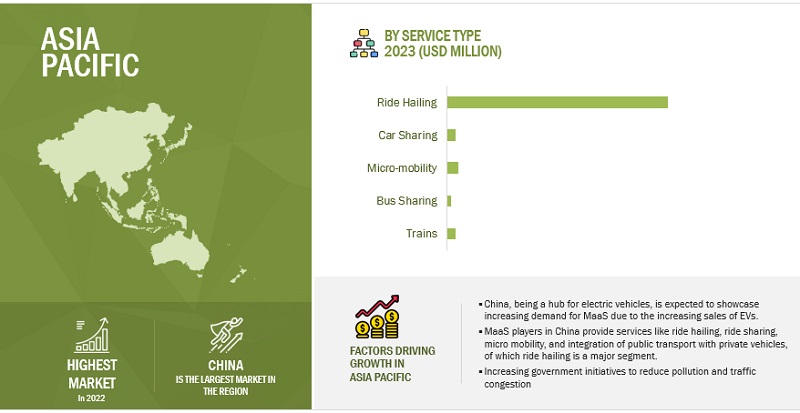
Key Market Players
The global mobility as a service market is led by established players, such as Moovit (Israel), MaaS Global (Finland), Citymapper (UK), FOD Mobility UK Ltd. (UK), and SkedGo (Australia), all of which adopted several strategies to gain traction in the market.
Get online access to the report on the World's First Market Intelligence Cloud
- Easy to Download Historical Data & Forecast Numbers
- Company Analysis Dashboard for high growth potential opportunities
- Research Analyst Access for customization & queries
- Competitor Analysis with Interactive dashboard
- Latest News, Updates & Trend analysis
Request Sample Scope of the Report
Get online access to the report on the World's First Market Intelligence Cloud
- Easy to Download Historical Data & Forecast Numbers
- Company Analysis Dashboard for high growth potential opportunities
- Research Analyst Access for customization & queries
- Competitor Analysis with Interactive dashboard
- Latest News, Updates & Trend analysis
|
Report Attribute |
Details |
|
The base year for estimation |
2022 |
|
Forecast period |
2023 - 2030 |
|
Market Growth forecast |
USD 40.1 Billion by 2030 from USD 5.7 Billion in 2023 at 32.2% CAGR |
|
Companies |
|
|
Segments Covered |
By Service Type, By Business Model, By Solution Type, Transportation type, Vehicle Type, Application Type, Operating Systems, Propulsion Type, Payment type, Commute type |
|
Region |
Asia Pacific (China, Japan, Singapore, Indonesia, Australia, India), North America (US, Canada, Mexico), Europe (Germany, France, Finland, Spain, Netherlands, Italy, Russia, UK, Turkey), Rest of the world (Brazil, South Africa) |
The study segments mobility as a service market based on By Service Type, By Business Model, By Solution Type, Transportation type, Vehicle Type, Application Type, Operating Systems, Propulsion Type, Payment type, Commute type, and the region at the regional and global level.
By Service
- Ride-Hailing
- Car Sharing
- Micro-Mobility
- Bus Sharing
- Train Services
By Business Model
- Business-To-Business
- Business-To-Consumer
- Peer-To-Peer
By Solution type
- Technology Platforms
- Payment Engines
- Navigation Solutions
- Telecom Connectivity Providers
- Ticketing Solutions
- Insurance Services
By Transporation type
- Private
- Public
By Vehicle type
- Buses
- Four-Wheelers
- Micro-Mobility
- Trains
By Application type
- Personalized Application Services
- Journey Management
- Journey Planning
- Flexible Payments & Transactions
By Operating System
- Android
- iOS
- Others
By Propulsion Type
- ICE
- EV
- Hybrid electric
- CNG/LPG
By Payment Type
- Subscription
- Pay-as-you-go
By Commute Type
- Daily
- Last mile connectivity
- Occasional
By Region
- North America
- Europe
- Asia Pacific
- RoW
Recent Developments
- Moovit, in November 2022, announced a new feature enabling commuters to decrease uncertainty and stress. The feature will allow Moovit users to follow their transit line’s movements along the map in real time for an additional layer of reliable information on route progress. Available for buses, trains, trams, subways, ferries, and even cable cars with GPS tracking, the feature will initially roll out in more than 220 cities across 38 countries.
- In October 2022, Cycling SDK by Citymapper helped integrate cycle routing and turn-by-turn navigation instantly, with just a few lines of code. SDK is designed to integrate seamlessly with the customer’s product and allows the configuration of colors, fonts, and icons to match the look and feel; it offers a choice of a range of features and details to match the use case.
- In October 2022, SkedGo announced its support for the Leicester Buses Partnership in the UK. This integration aims to provide travelers with personalized, door-to-door bus trip planning based on their preferences. Additionally, it serves as a platform to highlight and encourage the utilization of various local bus travel choices available in the area.
Frequently Asked Questions (FAQ):
What is the current size of the Mobility as a Service market?
Mobility as a Service market is projected to grow from USD 5.7 Billion in 2023 to USD 40.1 Billion by 2030, at a CAGR of 32.2% over the forecast period.
Who are the top key players in the Mobility as a Service market?
The global mobility as a service market is led by established players, such as Moovit (Israel), MaaS Global (Finland), Citymapper (UK), FOD Mobility UK Ltd. (UK), and SkedGo (Australia)
What are the trends in the Mobility as a Service market?
Increasing use of autonomous cars and electric vehicles
Use of big data to refine MaaS offerings
Inclusion of on-demand ferry and freight services.
Which are the most prominent factors driving the Mobility as a Service market?
Increasing smart city initiatives
Improvements in 4G/5G infrastructure and penetration of smartphones
Need to reduce CO2 emission.
What are the new opportunities in the mobility as a service market?
Increasing use of autonomous cars and electric vehicles
Use of big data to refine MaaS offerings
Inclusion of on-demand ferry and freight services
To speak to our analyst for a discussion on the above findings, click Speak to Analyst
Various secondary sources, directories, and databases have been used to identify and collect information for an extensive study of the mobility as a service (MaaS) market. The study involved four main activities in estimating the current size of the MaaS market: secondary research, validation through primary research, assumptions, and market analysis. Exhaustive secondary research was carried out to collect information on the market, such as the service types as well as the upcoming technologies and trends. The next step was to validate these findings, assumptions, and market analysis with industry experts across the value chain through primary research. The top-down approach was employed to estimate the complete market size for different segments considered in this study.
Secondary Research
The secondary sources referred to for this research study include company publications, technical journals, white papers, magazines, trade & business publications, and other articles published by transport associations. Secondary data was collected and analyzed to arrive at the overall market size, which was further validated through primary research.
Primary Research
Extensive primary research was conducted after obtaining an understanding of mobility as a service market through secondary research. Several primary interviews were conducted with experts from both the demand and supply sides across three major regions—North America, Europe, and Asia Pacific. Participants include taxi service and ride-hailing service providers, public transport companies, car-sharing platforms, and other technology vendors for MaaS apps. Primary data was collected through questionnaires, e-mails, and telephonic interviews. During the canvassing of primaries, we have tried to cover various departments within organizations, including sales, operations, and administration, to provide a holistic viewpoint in our reports.
After interacting with industry participants, we conducted brief sessions with experienced independent consultants to confirm the findings from the primaries. This, along with opinions from in-house subject matter experts, led us to the findings described in the remainder of this report.
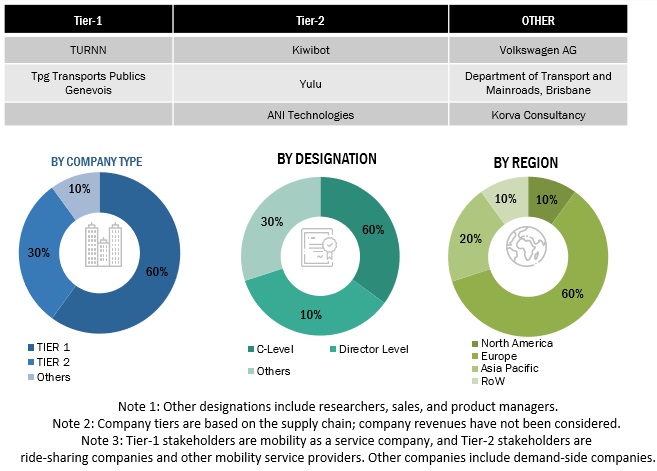
To know about the assumptions considered for the study, download the pdf brochure
Market Size Estimation
Bottom-Up Approach
The bottom-up approach was used to estimate and validate the size of the MaaS market by service type, transportation type, and vehicle type. To determine the MaaS market size by service type, the country-level estimated share of the MaaS market for each service was multiplied by the overall ride-sharing market, which includes ride-hailing, car sharing, micro-mobility, bus sharing, and train services.
The country-level market sizes were summed up to arrive at the regional market sizes, which were further totaled to derive the global MaaS market size.
Bottom-Up Approach: Mobility as a Service Market
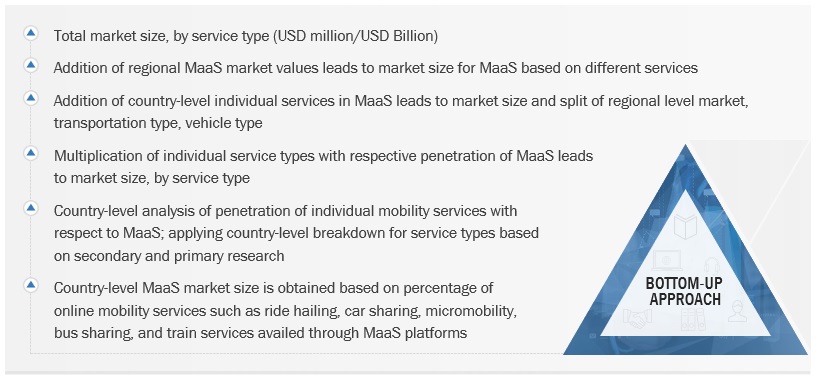
To know about the assumptions considered for the study, Request for Free Sample Report
Top-Down Approach
The market sizes of the business model, propulsion type, mode, solution type, operating system, and application type segments were derived using a top-down approach and were based on the country-level penetration of MaaS and sub-segments. For instance, the application type segment size was derived based on the penetration of MaaS across different countries and the usage level of people. The business model segment size was derived based on acceptance patterns in business-to-business vs. business-to-consumer models, along with penetration in the peer-to-peer model.
The regional market for transportation type and vehicle type was derived by adding up the market numbers for different services relevant to specific transportation or vehicle types.
Top-Down Approach: Mobility as a Service Market

Data Triangulation
All percentage shares, splits, and breakdowns were determined using secondary sources and verified through primary sources. All parameters that are expected to affect the markets covered in this research study were accounted for, viewed in extensive detail, verified through primary research, and analyzed to obtain the final quantitative and qualitative data. This data was consolidated, supplemented with detailed inputs and analysis from MarketsandMarkets, and presented in the report.
Market Definition
Mobility as a Service (MaaS) is the integration of and access to different transport services (such as public transport, ride-sharing, car sharing, bike-sharing, scooter-sharing, taxi, car rental, and ride-hailing) in a single digital mobility offering, with active mobility and an efficient public transport system at its base. This tailor-made service suggests the most suitable solutions based on a user’s travel needs. MaaS is available anytime and offers integrated planning, booking, and payment, as well as en route information to provide easy mobility without having to own a car.
Stakeholders
- Investment Firms
- Mobility as a Service Solution Provider
- Ride Sharing Service Providers
- Public Transport Organizations
- Regulatory Authorities
Report Objectives
- To describe and forecast the mobility as a service market, in terms of value, based on By Service Type, By Business Model, By Solution Type, Transportation type, Vehicle Type, Application Type, Operating Systems, Propulsion Type, Payment type, Commute type.
- To describe and forecast the mobility as a service market size, in terms of value, with respect to 4 main regions, namely, North America, Europe, Asia Pacific, and the Rest of the World (RoW)
- To provide detailed information regarding the major factors influencing the growth of the market (drivers, restraints, opportunities, and industry-specific challenges).
- To strategically analyze the market through Porter’s Five Forces analysis, trade analysis, trends/disruptions impacting buyers, case studies, patent analysis, supply chain analysis, market ecosystem, regulatory analysis, and technology trends.
- To analyze the market share of leading players in the mobility as a service market and evaluate competitive leadership mapping.
- To strategically analyze the key player strategies/right to win and company revenue analysis.
- To analyze the opportunities in the market for stakeholders and provide details of the competitive landscape for market leaders.
- To provide an analysis of recent developments, alliances, joint ventures, mergers & acquisitions, product launches, and other activities carried out by key industry participants in the mobility as a service market.
Additional Customization
With the given market data, MarketsandMarkets offers customizations to meet the company’s specific needs.
- Country-wise information
- Analysis of additional countries (up to five)
- Company Information
- Detailed analysis and profiling of additional market players (up to five)




 Generating Response ...
Generating Response ...







Growth opportunities and latent adjacency in Mobility as a Service Market
mobility as a service market report was published in Dec 2021, and it covers the market trends and growth factors with respect to Mobility as a Service Market. It also covered the Market estimations of Mobility as a Service in terms of Value by Services/ Solutions/ Application / Transportation/ Vehicle/ Operating System/ Business Model/ Propulsion at regional and country level for the period 2020-2030. The report also covers the detail competitive landscape with key players Market Share Analysis, Developments of Key Market Players Like There Contracts & Agreements, Investments & Expansions, Joint Venture, Partnerships, And Collaborations and their Business Overview, Products/solutions/services Offered, Recent Developments, SWOT Analysis. We track this market since last 4 years and this is our latest edition providing the regional level addressable market size and growth forecast and forecast factors that impact the growth rate, for Insurance services as well as other services, such as Technology Platforms, Ticketing, Navigation, Telecom Connectivity Providers, payment engines, etc.
Mobility as a service market research study involved the use of extensive secondary sources, directories, and databases to classify and gather facts and figures useful for this technical, market-oriented, and commercial study of mobility as a service (MaaS) market. 1) The study involves four main activities to estimate the current size of the Mobility as a service (MaaS) market: Secondary research, Validation of findings through Primaries, Assumptions, and Market analysis. 2) Exhaustive secondary research was done to collect information on the market, such as the service types, upcoming technologies and trends. 3) The next step was to validate these findings, assumptions, and market analysis with industry experts across value chains through primary research. Top-down approach was employed to estimate the complete market size for different segments considered under this study. 4) The MaaS market is very dynamic owing to the constant developments taking place in the mobility ecosystem. As the research covers a niche market, the data available in secondary sources is very limited. Hence, the report is driven through primary interviews. 5) We connected with industry experts such as taxi service suppliers, app developers, OEMs, and other experts for primary interviews to understand the future trends, growth drivers, and challenges in this market. 6) The MaaS market size, in terms of value (USD billion/million), for various regions has been derived using forecasting techniques based on the demand and offering trends of the services.
Which are the top technologies that will reshape the mobility as a service market?
We are interested in Mobility as a Service Market report which covers the topics like end-to-end trip planning, electronic ticketing, and payment services across all modes of public and private transportation.
We are interested in Mobility as a Service Market size for the North US region for the 2022 to 2027 Forecast year.
What is the market size for the North American region for the estimated forecast period?
We would like to know about the ride hailing /ride sharing industry statistics, market share and size in Singapore .
I am working on my study these for the Master 2 in Exploitation and network development at Cergy University. The theme of my these is about micro mobility and other networks influence. Thank you.
Determining the size of the demand for peer to peer and owner operated car sharing when considering ownership changing radically over the next 5 years - to such an extent that current owners will not renew their cars, buy sign up to sharing platforms in order to get access to a much wider range of vehicles to suit their varying needs and desires. If 5 of global owners did this, and each owner had 10 trips per year (Low case) - the demand for shared cars would be huge. What do you think ?